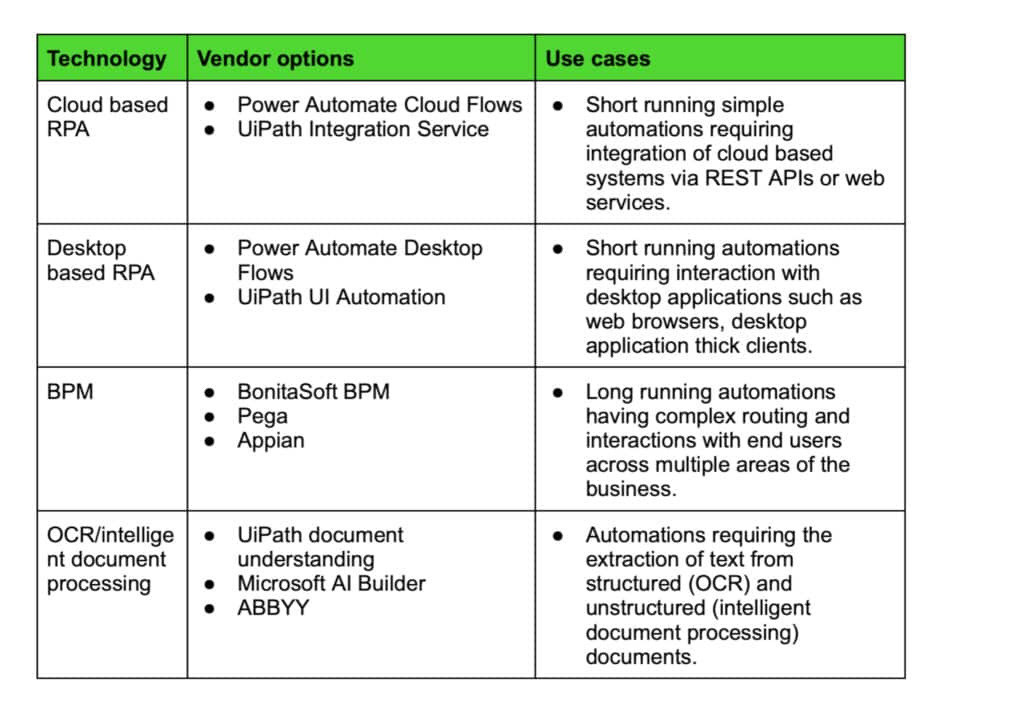The automation technology landscape is filled with a wide range of vendors, functions and features, each promising their product is the best solution for your business. This can make the prospect of automation technology selection daunting, not only if it is a new capability in your business, but also to ensure you are getting the most out of the constantly changing technology options available.
In our experience you need to work backwards; considering your use cases, business goals and objectives, internal skillset and environment to help determine the right automation technology for your organisation. In this blog I will provide some guidelines that will work through the key factors to consider when selecting automation technology.
Problem identification
Before jumping into ‘solution’ mode, it’s worth taking the time to understand the problem at hand and also taking the time to consider if there are other similar problems which may arise in the future. Some of the key considerations are:
- What is the cause and impact of the problem?
- Based on the impact, what is the desired time for resolution?
- How many systems are involved and are they internal or external to your business?
Building the Business Case
If your business is in the early stages of automation, it can be very useful to consider other business areas which could also benefit. For example, if one area is performing manual, repetitive tasks as part of their standard business processes, then odds are that there are other areas of the business doing the same. In these situations, reach out to other business areas to discuss potential areas of improvement and develop an initial backlog of improvement ideas. This can help not only from a business buy-in perspective but also from a budgeting perspective.
Which flavour of Automation?
Once you have an initial list and understanding of improvement ideas, it’s time to work through them one by one to identify the most appropriate solution approach. At this point, it can be helpful to call on the assistance of an external party to help you tease out the technical details and provide possible solutions. Some of the key considerations are:
- Is the business process duration short or long? If long, then BPM might be a good fit.
- Is the business process simple or complex? RPA is better suited to simple processes whereas BPM is more appropriate where the process is complex and involves the interaction of users across multiple areas of the business.
- Is the business process well defined and documented? If yes, RPA might be a good candidate.
- Does the business process change and if so, how often and to what extent? For example, business processes which are governed by regulatory bodies might need to be flexible enough to handle changes in legislation. This won’t necessarily rule out any technology choices but it will certainly be an important consideration in the solution design.
- Does the business process have a large number of exception scenarios? In general, RPA is better suited to handling a limited number of well defined exception scenarios.
- Is there a need for integration with desktop applications? This will help determine whether desktop RPA is required and to what extent.
- Is there a need for integration with other systems, web services or REST APIs? This won’t necessarily rule out any technology options but if all of your integrations are cloud based, there is no need to invest in a RPA technology which focuses on desktop automation for example.
- Does the process involve complex business rules and how frequently do these rules change? A rules engine might be incorporated to help manage these scenarios.
- Is there a need for automated document processing (for example, extraction of text from PDF files)? If so, OCR and/or intelligent document processing might be appropriate.
An additional consideration is whether the business should undertake any business process re-engineering prior to developing the automation. There is no right or wrong answer to this question but if the business is looking for the quickest return on investment, often it can make sense to focus on automating the business processes in their current form while spending time behind the scenes to re-engineer it. Then, once the current business process automation has been rolled out bringing the immediate benefits to the business, work can start on implementing the re-engineered business process to bring about further benefits. Obviously, this needs to be considered on a case by case basis, but in our experience attempting to perform the re-engineering before embarking upon the automation journey can lead to analysis paralysis and the loss of any initial momentum.
Technology selection
Once each of the improvement ideas has been teased out, you should start to have an idea of the types of technologies required to develop solutions, whether they be business process management (BPM) tools, automated document processing, cloud based integration platforms or low code app development platforms.
At a high level, the following table can be used as a starting point, however keep in mind that the features and services offered by the various vendor products each can and do change quickly.

It is at this point that you can start to take stock of what technologies and skills you have in house and start/continue to engage with external consultants (such as Intelligent Pathways) to make sure the automation technologies chosen will integrate with your existing technology stack and bring about business benefits well into the future.
Intelligent Pathways is well placed to assist you on your automation journey, regardless of whether you are just starting out or looking to embark upon the next phase so please reach out to see how we can assist.


